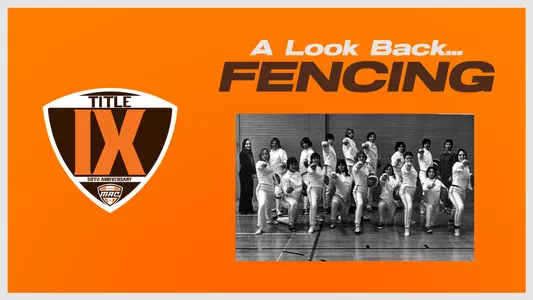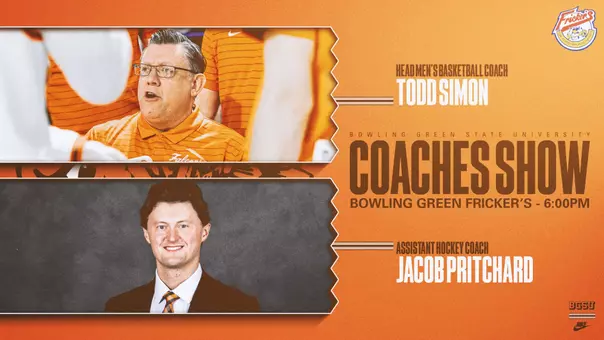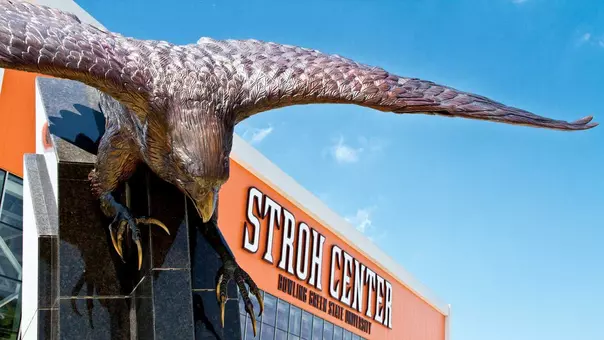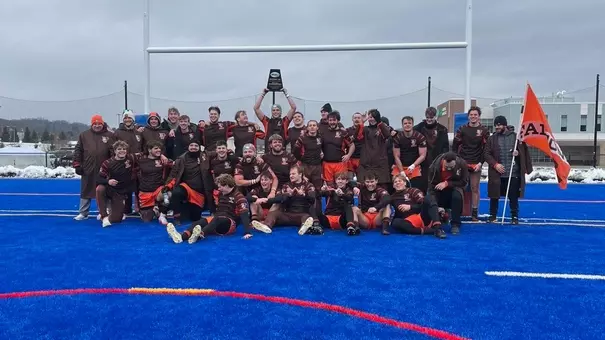Bowling Green State University Athletics

Title IX: A Look Back at Fencing
September 22, 2022 | General
BOWLING GREEN, Ohio - In celebration of the 50th Anniversary of Title IX, BGSU athletics is taking a look at the history of women's sports throughout the years. The information in this series was lifted from the book 'Forward Falcons: Women's Sports at Bowling Green State University' written by Janet B. Parks, Ann Bowers, and Adelia Hostetler Muti. Forward Falcons documents and preserves the history of Bowling Green State University women's sports from 1914 through 1982. During these pree-NCAA years, women coached most of the teams, and organizations composed primarily of women set the program standards.
To read the entire book, you can go to: https://scholarworks.bgsu.edu/bgsu_books/3/
This series will also include some of our Heritage Sports and current teams.
Fencing
In 1945, Iris Andrews organized the first fencing club on the BGSU campus, and the members competed against Ohio State and the University of Michigan. The 1954 Key listed fencing as one of the 10 clubs sponsored by the Women's Recreation Association.
In January 1969, a coed fencing club was formally organized with support from the Health and Physical Education Department. Fencing course instructors were WHPE faculty member Beverly Zanger and graduate student and former Ohio State letter-winning fencer, Kenneth Mitchell. It was their intent to expand the sport from club to intercollegiate competition.
In 1971 and 1972, Mitchell coached the men, and Zanger coached the women. Although it was a coeducational team, the women and men competed separately, with the men competing in foil, epee, and/or saber categories, and the women only in the foil category (lighter blades and torso as the target). Electrical equipment was used to help train the fencers allowing them to develop quickness, leg strength, and endurance.
The Falcon fencing teams were competitive during the mid-1970s, scheduling matches with teams from schools such as Ohio State, Cleveland State, Wisconsin-Parkside, Michigan, Miami, Kent State, Notre Dame, Oberlin, Windsor, Wisconsin, Culver Military Academy, and Case Western Reserve. In 1975, Zanger noted the improvement in the women's performance: "This is the first year that there's been much recognition for the sport. That's because this is the first year we've really put on a pretty good showing."
After losing the first four matches of the 1976 schedule, "the BG women then made a spectacular comeback effort as they won their next four matches, blitzing Windsor, 16-0; dumping Cleveland State, 13-3; slipping past Notre Dame, 9-7; and pasting Kent State University, 14-2" (Key, 1976, p. 158). Zanger characterized the women's victory over Notre Dame as "the highlight of the meet."
In January 1978, the University Athletics Committee recommended that fencing be discontinued as an intercollegiate sport. The sport was dropped at the end of the competitive season, and Zanger returned to full-time teaching in physical education. Coed fencing continued to operate as a club sport for several years.
To follow our current fencing club, you can find them on Twitter at @bg_fencing or Instagram @bgfencing.
To read the entire book, you can go to: https://scholarworks.bgsu.edu/bgsu_books/3/
This series will also include some of our Heritage Sports and current teams.
Fencing
In 1945, Iris Andrews organized the first fencing club on the BGSU campus, and the members competed against Ohio State and the University of Michigan. The 1954 Key listed fencing as one of the 10 clubs sponsored by the Women's Recreation Association.
In January 1969, a coed fencing club was formally organized with support from the Health and Physical Education Department. Fencing course instructors were WHPE faculty member Beverly Zanger and graduate student and former Ohio State letter-winning fencer, Kenneth Mitchell. It was their intent to expand the sport from club to intercollegiate competition.
In 1971 and 1972, Mitchell coached the men, and Zanger coached the women. Although it was a coeducational team, the women and men competed separately, with the men competing in foil, epee, and/or saber categories, and the women only in the foil category (lighter blades and torso as the target). Electrical equipment was used to help train the fencers allowing them to develop quickness, leg strength, and endurance.
The Falcon fencing teams were competitive during the mid-1970s, scheduling matches with teams from schools such as Ohio State, Cleveland State, Wisconsin-Parkside, Michigan, Miami, Kent State, Notre Dame, Oberlin, Windsor, Wisconsin, Culver Military Academy, and Case Western Reserve. In 1975, Zanger noted the improvement in the women's performance: "This is the first year that there's been much recognition for the sport. That's because this is the first year we've really put on a pretty good showing."
After losing the first four matches of the 1976 schedule, "the BG women then made a spectacular comeback effort as they won their next four matches, blitzing Windsor, 16-0; dumping Cleveland State, 13-3; slipping past Notre Dame, 9-7; and pasting Kent State University, 14-2" (Key, 1976, p. 158). Zanger characterized the women's victory over Notre Dame as "the highlight of the meet."
In January 1978, the University Athletics Committee recommended that fencing be discontinued as an intercollegiate sport. The sport was dropped at the end of the competitive season, and Zanger returned to full-time teaching in physical education. Coed fencing continued to operate as a club sport for several years.
To follow our current fencing club, you can find them on Twitter at @bg_fencing or Instagram @bgfencing.
BG MBB : Postgame Interviews 12.16
Wednesday, December 17
BG WBB : Postgame Interviews 12.16
Tuesday, December 16
BG WBB : Postgame Interviews 12.14
Sunday, December 14
BG MBB : Postgame Interviews 12.7
Monday, December 08




